|
|
|
|
|
|
Left part of three-register bas relief (top, bottom, and left edges original; surface partly eroded).
Upper register: two bearded and barefoot soldiers with fillets, sword, and quiver, dressed in short tunics striding to the left pulling a two-horse royal (?) chariot; over the horses are two symbols, a round one and a winged disk, suggesting a royal passenger.
Middle register: no inscription.
Lower register: eunuch with long tunic holding a fly-whisk walking to the right behind the king in tiara (whose tip breaks into the middle register) with a long band, wearing a long tunic and sword. <see also Court Scenes>
|
|
Date: period of Tiglathpilesar III
Material: Mosul alabaster
Dimensions: H = 2.23m; max. W = 0.93m; Th = 0.12m; H of upper register = 0.81m; H of middle register = 0.28m; H of lower register = 0.80m; H of plinth = 0.35m
Provenance: square N10/W30
Inv. # NA5-75
(hover cursor over photo or plan to zoom)
|
 |
|
|
|
|
|
Complete corner bas relief slab with two rows of figures separated by an inscription band and a full-height sacred tree at the corner.
Corner tree has palmettes placed symmetrically on both sides of the corner; the tree is narrow.
The upper register depicts a bearded warrior in a short tunic looking left; he carries a spear (whose end is on the next slab to the left) and shield. The very end of what appears to be a sword of the person on the next slab is seen below the figure's spear.
The middle register contains two 7-line inscriptions (one on each side of the corner), surrounded and divided by guidelines.
The lower register depicts part of a post-battle victory procession. There is one bearded warrior in a short tunic wearing a pointed helmet facing left. He carries a sword and spear. The ends of his right foot and hand are on the next slab to the left. Fragments of a large shield from the adjacent slab can be seen above this figure's spear.
(see also reliefs of sacred trees and field battles for discussion of the inscriptions)
|
Date: Unspecified
Material: Not specified
Dimensions: H total = 2.56m; W of left part = 0.57m; W of right part = 0.30m; Th = 0.16m; H of base = 0.61m; H of lower register = 0.89; H of middle register = 0.19; H of upper register = 0.87m
Provenance: square N10/W30, c.0.30m above pavement
Inv. # NA12-76
(hover cursor over photos or plan to zoom)
|
 |
|
|
|
|
|
|
|
|
Two joining fragments of a bas relief depicting two figures facing right wearing ankle-length tunics (top edge original; surface badly eroded).
Right-hand figure appears to be beardless; left figure appears to have a beard. Their hair does not break the line of their shoulders. They may or may not be wearing sandals. Both have their hands raised in front of them.
It is possible the relief originally formed part of the Babylonian campaign narrative, as in the drawing (below left) from Barnett & Falkner (1962), plate 1, series A, upper slab 5a (in Woburn Abbey).
|
|
Date: Unspecified
Material: Mosul alabaster
Dimensions: H = 1.02m; max. W = 0.64m; Th = 0.07m
Provenance: square N10/W30
Inv. # NA2-75
(hover cursor over photo or plan to zoom; click here to enlarge the photo or the drawing)
|
 |
|
|
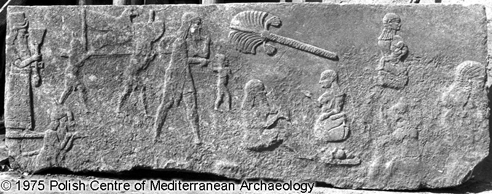
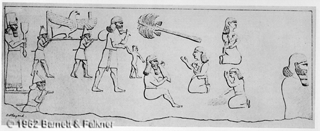
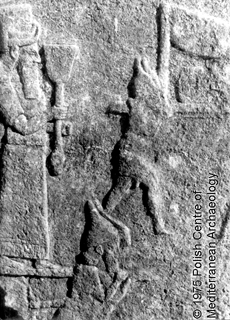
detail of booty
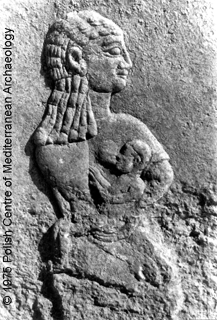
upper nursing mother

(top or bottom of slab showing various cuttings;
drawing probably by Richard Sobolewski)
|
|
Part of the upper register of a bas relief depicting the scene outside a conquered city (which could have been represented on the slab to the left); top, left and right sides original; surface somewhat eroded.
Soldiers carry the statues of Marduk and the symbol of Nimrute (an eagle) and other booty.
Observations: two nursing mothers; woman facing left, below the upper nursing mother, may be facing a baby on the ground; bottom edge perhaps has fragments of other booty being carried.
This relief matches a presumed-lost relief originally forming part of the Babylonian campaign narrative, as seen in the drawing (above left) from Barnett & Falkner (1962), plate 7, series A, upper slab 6a.
|
|
Date: period of Tiglathpilesar III
Material: Mosul alabaster
Dimensions: H = 0.52m; W. 1.61m; Th 0.10m
Provenance: square N10/W30
Inv. # NA3-75
(hover cursor over top photo or plan to zoom; click here to enlarge the photo of the full relief or the drawing)
|
 |
|
|
|


(top, bottom, or side of relief showing various cuttings;
drawing probably by Richard Sobolewski)
|
| Left fragmentary portion of a bas relief depicting a chariot wheel with 8 spokes and the legs of its horse, moving to the right (left edge original); a small section (max. H of 0.12m) of the middle register survives under the horse. |
|
Date: period of Tiglathpilesar III
Material: Mosul alabaster
Dimensions: H = 0.28m; max. W = 0.75m; Th = 0.11m
Provenance: square N10/W30
Inv. # NA11-75
(hover cursor over photo or plan to zoom; click here to enlarge the photo)
|
 |
|
|
|
|
|
|
Relief depicting a bearded charioteer followed by spearmen, moving left (head of horse carved on next slab to the left).
To the right is the eroded silhouette of a bowman, facing right toward a besieged city, drawing his bow. A small tree separates the scenes. (see also reliefs of siege scenes)
This relief matches a presumed-lost relief, as seen in the drawing (left) from Barnett & Falkner (1962), plate 9, series A, upper slab 4a. Possibly part of the Babylonian campaign narrative.
|
|
Date: period of Tiglathpilesar III
Material: Mosul alabaster
Dimensions: total H = 1.03m; H of upper register = 0.89-0.97m; max. W = 1.67m; Th = 0.12m
Provenance: square N10/W30, SE corner
Inv. # NA12-75
(hover cursor over photo or plan to zoom; click here to enlarge the photo or drawing)
|
 |
|
|
|
|
| Right upper part of a relief slab depicting part of a victory procession with three bearded musicians, facing right, leading two horses. |
Date: period of Tiglathpilesar III
Material: Mosul alabaster
Dimensions: H = 0.75m; W = 0.97m; Th = 0.13m (found in two pieces; right and top edges original)
Provenance: square N0/W30
Inv. # NA70-75
(hover cursor over photo or plan to zoom; click here to enlarge the photo)
|
 |
|
top |
|
|
|
|
|
|
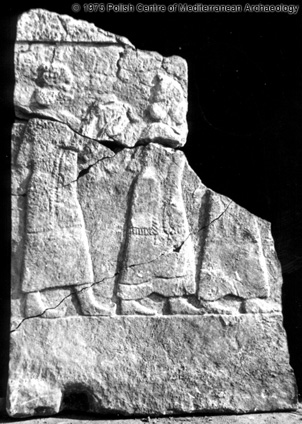
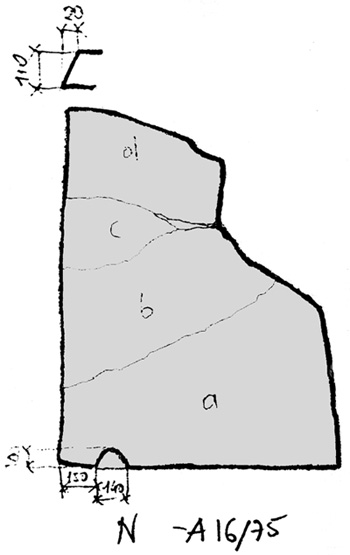
(top or bottom and front of slab showing various cuttings;
drawing probably by Richard Sobolewski)
|
| Lower left corner of a relief (broken into four pieces) depicting three tribute bearers moving toward the right (bottom and left sides original; possibly from the Anatolian or Arab campaign).
The poses, hairstyles, and garments of the three figures is very similar to the line of male figures depicted on NA17-75 (see directly below). Thus, we conclude this relief is from the same narrative sequence (Paley 2008:216).
The carving on this relief is more worn and damaged, so we cannot determine what the figures carried. For a more detailed discussion of their clothing, see NA17-75, below.
The notched cut in the lower left of the plinth is typical of Assyrian wall reliefs and was used to help lever the slab into place along the wall (there would have been a corresponding notch near the lower right corner of the slab).
|
|
Date: period of Tiglathpilesar III
Material: Mosul alabaster
Dimensions: H = 1.33m; max. W = 0.97m; Th = 0.11m; H of plinth = 0.33m; H of lower register = 0.91m
Provenance: square N0/W30 & N10/W30 in separate pieces
Inv. # NA16-75
(hover cursor over photo or plan to zoom; click here to enlarge the photo)
|
 |
|
|
|
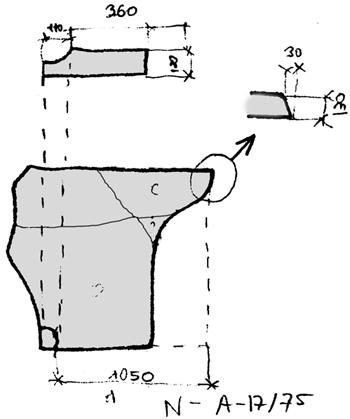
(top or bottom and front of slab showing various cuttings;
drawing probably by Richard Sobolewski)
|
Lower part of a typical three-part relief depicting a procession of male tribute bearers moving toward the right (possibly toward the king). Although the three men seem slightly different in height, with slightly different caps, they seem, for the most part, to be dressed alike: a fringed shawl over a long tunic, fringed at the bottom, and footwear with upturned toes. Each figure carries something different. The first figure is too incomplete to know what he held; the middle figure has a sack over his shoulders; and the last figure holds a bowl (phiale) in one hand and a large V-shaped bowl in the other (Paley 2008:215).
At the far left is part of a fortified city wall (lower and part of right edge original). The partial wall seems to match the carving of the rest of a walled city shown on a relief now in the Louvre (AO19855) and also published by Barnett & Falkner (1962), plate 45, series B, lower slab 14b (copied at the lower left).
This relief, and the one to its left, may belong to a long narrative depicting the so-called Arab or Anatolian campaign of Tiglath-pileser III.
Middle register (above the figures) is uninscribed.
This relief matches a presumed-lost relief, as seen in the drawing (below left) from Barnett & Falkner (1962), plate 47, series B, lower slab 10b.
|
Date: period of Tiglathpilesar III
Material: Mosul alabaster
Dimensions: H = 1.46m; max. W = 1.37m; Th = 0.12m; H of plinth = 0.33m; H of lower register = 0.91m
Provenance: square N10/W30, SW corner
Inv. # NA17-75
(hover cursor over photo or plan to zoom; click here to enlarge the photo or drawing)
|
 |
|
|
|
|
| Fragment of a bas relief depicting a royal arms bearer (possibly a eunuch) facing left carrying a bow and sword (or mace), possibly standing behind a throne. He wears a long tunic with fringed sleeves.
Right edge original.
It is possible that the fragment originated from the figure standing behind the king shown on a presumed-lost relief published (below left) by Barnett & Falkner (1962), plate 18, series A, lower slab 9b.
|
|
Date: period of Tiglathpilesar III
Material: Mosul alabaster
Dimensions: H = 0.49m; W = 0.24m; Th = 0.13m
Provenance: square N10/W30
Inv. # NA35-75
(hover cursor over photo or plan to zoom; click here to enlarge the photo)
|
 |
|
|
 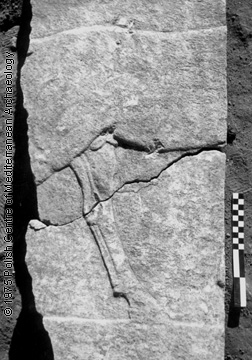
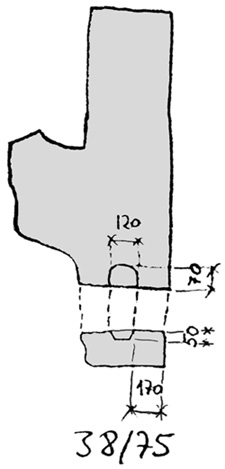
(top or bottom and front or back of slab showing various cuttings;
drawing probably by Richard Sobolewski)
|
Lower right section of a typical three-register relief depicting part of a horse moving to the right (possibly as part of a procession of booty). Scene would have continued onto the next relief slab to the right.
The lower part of the middle register is visible at the top of the slab.
|
Date: period of Tiglathpilesar III
Material: Mosul alabaster
Dimensions: H = 1.55m; W = 0.54m; Th = 0.13m; H of lower register = 0.90m (bottom and right edges seem original)
Provenance: square N10/W30 (found in three pieces)
Inv. # NA38-75
(hover cursor over photos or plan to zoom; click here to enlarge the full photo or detail)
|
 |
|
|
|
|
|
Part of the lower register of a typical three-register bas relief probably depicting two tribute bearers (bottom edge original).
The figures face left and wear mid-length tunics. There is part of an unidentifiable figure or object along the left broken edge (the excavators suggest this might be the ends of a lion's paws).
|
Date: Unspecified
Material: Not specified
Dimensions: decoration H = 0.55m; W = 0.64m; Th = 0.12m; H of plinth = 0.40m
Provenance: square N0/W30, c.2.0m north of the SW corner of the square, c.0.30m above the pavement
Inv. # NA24-76
(hover cursor over photo or plan to zoom; click here to enlarge the photo)
|
 |
|
|
|
|
|